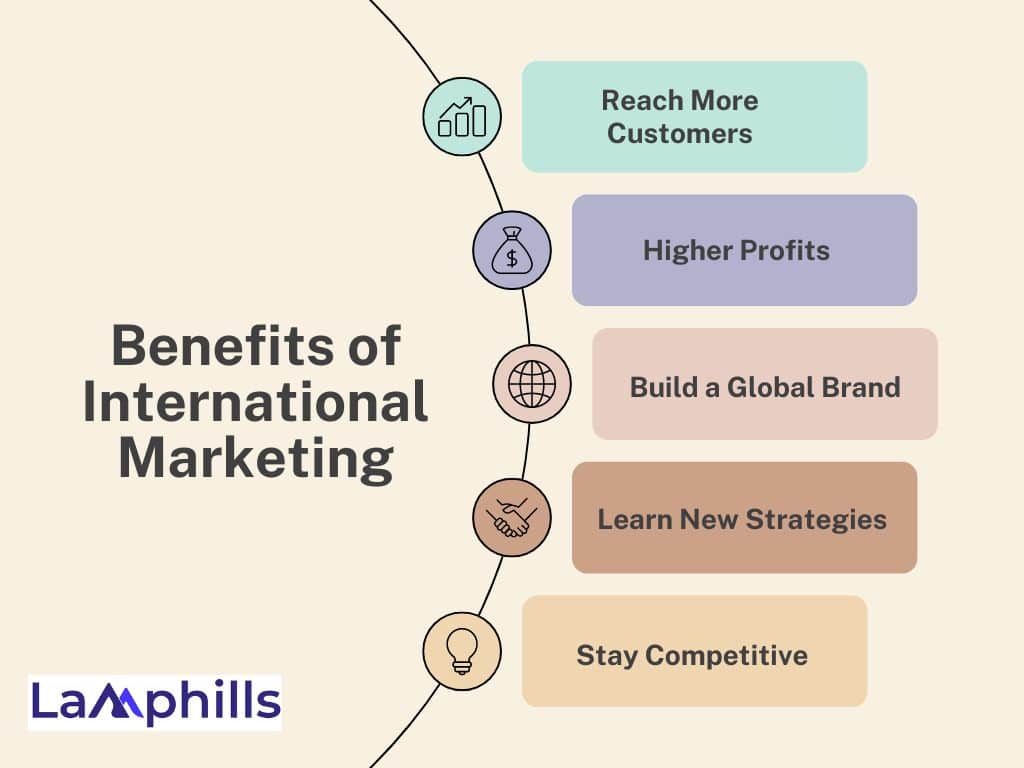Growing your brand worldwide can be tough. It’s hard to figure out where to begin and how to ensure your message connects with different groups of people. The solution is to have an international marketing plan which can help your business succeed globally.
When I first heard about international marketing, it seemed difficult. I thought only big companies could do it. But as I learned more, I realized that any business can reach customers in other countries with the right plan. International marketing is about adjusting your products, services, and advertising to meet the needs of people from different places.
In this article, I’ll explain what international marketing is, share some examples, and show you how to take advantage of global growth opportunities.
Keep reading to find out how to reach a global audience!
Key Points
- International marketing means promoting and selling products or services in different countries by adjusting to local cultures, languages, and customer needs, making sure your brand connects with people worldwide.
- Going global helps businesses reach more customers, increase sales, make bigger profits, and build a strong brand like Coca-Cola, Nike, or Samsung.
- To succeed in international marketing, you need to adjust your products, services, and ads to fit each market’s unique needs.
- Businesses can expand globally using methods like exporting, licensing, franchising, joint ventures, or direct investments, each offering a different way to enter new markets.
- International marketing needs flexibility, which means doing research, improving SEO, and changing products or ads to fit local customs and preferences.
What is international marketing?
International marketing is when companies promote and sell their products or services to people in different countries. It means adjusting what they offer to fit the needs, preferences, and languages of customers around the world.
Companies may change their messages, product features, and sales methods to match local customs. This helps them expand their business, make their brand known globally, and succeed in international markets.
In simple terms, international marketing involves promoting and selling your products or services in multiple countries. It’s about expanding your business beyond your home country, understanding what people in other places want, and delivering that in a way that resonates with them. It’s more than just translating a website; it’s about adjusting your entire marketing strategy to fit new markets’ cultural and social norms.
International vs. Local Marketing
Unlike local marketing, an international marketing campaign focuses on the different needs, preferences, cultural differences, and rules of markets around the world.
Here’s a look at the key differences between international and local marketing:
| International Marketing | Local Marketing | |
| Scope | Targets audiences across multiple countries and regions | Focuses on a specific geographic area within a single country. |
| Languages | Involves multiple languages and translation services. | Primarily uses the dominant language of the target market. |
| Culture | Requires understanding and adapting to diverse cultural norms. | Leverages familiarity with the local culture. |
| Regulations | Must comply with varying laws, trade restrictions, and regulations in different countries. | Operates within the legal framework of a single country. |
| Currency | May involve transactions in multiple currencies with exchange rate considerations. | Uses a single currency. |
| Competition | Faces competition from both global and local businesses. | Competition comes mainly from businesses within the local market. |
| Cost | Requires higher investment for research, translation, and logistics. | Typically involves lower costs compared to international marketing. |
Examples of International Marketing
One example that really helped me understand international marketing is how McDonald’s operates worldwide. Wherever they go, they tweak their menu to suit local tastes. For instance, they offer a McVeggie burger in India, where many people don’t eat beef. Yet, they still maintain their recognizable brand image everywhere.
Similarly, I admire Netflix’s international success. It started in the U.S. but now operates globally. Netflix invests in local content—like Korean dramas in South Korea and Spanish shows in Spain—while ensuring its overall brand appeals to viewers worldwide.
Other examples include:
#1. Coca-Cola
Coca-Cola is a great example of international marketing because they sell their drinks in almost every country around the world. They adjust their marketing based on local cultures and preferences. For example:
- In Japan, Coca-Cola created drinks like green tea and flavored water to appeal to local tastes.
- In Muslim-majority countries, Coca-Cola highlights how their product can be enjoyed with family and during special occasions like Ramadan.
Coca-Cola also changes its ads and messages to fit the local language and customs, making it feel familiar to people in each country, even though it’s a global brand.
#2. Toyota
Toyota, the car company from Japan, uses international marketing to sell cars in many different countries. They do this by:
- Building cars that fit the needs of each region. For example, Toyota might sell smaller, fuel-efficient cars in Europe, where people care more about fuel economy, while they sell larger trucks in the United States, where trucks are popular.
- Toyota adjusts its ads to match local cultures and lifestyles. In some countries, Toyota promotes its cars as practical family vehicles, while in others, it focuses on the latest technology and features.
By customizing their cars and marketing messages to different regions, Toyota successfully reaches customers all around the world.
#3. Samsung
Samsung, the electronics company from South Korea, uses international marketing to sell smartphones, TVs, and other tech products worldwide. They succeed in different markets by:
- Adapting to the needs of local consumers. For instance, in India, Samsung offers budget-friendly smartphones with features important to local buyers, like strong batteries and affordable prices.
- Promoting different products in different regions. For example, in countries where gaming is very popular, Samsung focuses on promoting its high-tech gaming monitors and phones.
Samsung also uses global events like the Olympics or World Cup to run ads that connect with people from various cultures, helping them grow their international presence.
#4. Nike
Nike is another strong example of international marketing. The sportswear company sells its products in nearly every country, and they adapt their marketing strategies to fit the local culture and preferences in each market. Here’s how:
- Local Sports Heroes: Nike often collaborates with local athletes to promote its products. For example, Nike works with Chinese basketball stars in China, while in Brazil, it partners with soccer players. This helps them connect with sports fans on a personal level in each country.
- Cultural Adaptation: Nike tailors its campaigns to local cultures. In Japan, they focus on fitness and health trends, while in Africa, Nike highlights social causes, like promoting sports for girls and youth empowerment. By understanding local values, Nike’s messaging resonates with people in each region.
- Special Products: Nike also releases special edition shoes and apparel that are designed specifically for certain markets. For example, they create limited-edition shoes for the Chinese New Year or football gear for the World Cup. This makes their products feel unique and relevant to different cultures.
Nike’s international marketing succeeds by blending its global brand image with local cultural influences, making it a top choice for athletes and sports enthusiasts all over the world.
These companies have mastered international marketing by adjusting their products, pricing, and advertising to fit the needs of local markets while still keeping their global identity intact.
Benefits of International Marketing

International marketing offers businesses the chance to grow and reach new customers outside of their home country. When a company goes global, it can tap into larger markets, increase sales, and build a stronger brand. In this section, I’ll explain the key benefits of international marketing and how it can help businesses succeed on a bigger scale.
1. Reach More Customers: The most significant benefit is the chance to connect with a much larger audience. For the clothing brand I worked with, moving beyond our local region meant getting orders from all over the world, multiplying our potential customer base.
2. Higher Profits: More customers usually mean more sales, which can lead to higher profits. Businesses that expand globally often see a boost in revenue as they can enter more profitable markets than just their home country.
3. Build a Global Brand: Expanding internationally also gives you the chance to become a global brand. If you succeed in different markets, your company could be known worldwide, like Starbucks or Nike.
4. Learn New Strategies: International marketing forces you to learn and adapt. I learned so much about cultural differences and how they impact customer behavior. These lessons helped me grow, not just as a marketer but as someone who understands global business better.
5. Stay Competitive: By entering international markets, you can stay ahead of competitors that only focus on local customers. Going global gives your brand a competitive edge.
In summary, international marketing opens up many opportunities for businesses to grow and reach more people around the world. While it can come with challenges, the benefits, like increased sales, a larger customer base, and stronger brand recognition, make it worth the effort.
Features of International Marketing
International marketing is about promoting and selling products or services to customers in different countries. To succeed, businesses need to consider several key features that help them reach global audiences effectively.
Here are the basic features:
- Global Reach: It focuses on reaching customers in multiple countries, not just in one place.
- Cultural Awareness: It takes into account the cultural differences, such as language, traditions, and customer preferences, in each country.
- Adapting Products: Sometimes, products need to be changed or customized to meet the needs and tastes of people in different countries.
- Currency and Pricing: Companies deal with different currencies and need to set prices based on local markets and exchange rates.
- Legal and Trade Rules: International marketing must follow the rules and regulations of each country, such as taxes, trade restrictions, and advertising laws.
- Logistics: It involves managing shipping, distribution, and delivery across borders.
- Communication Strategies: Marketing messages may need to be adapted to fit the language and culture of each region to connect better with local audiences.
By understanding and applying these features, companies can better connect with customers around the world, navigate different markets, and grow their businesses internationally.
Types of International Marketing

When businesses decide to expand into other countries, they can use different types of international marketing strategies to reach new customers. Each type focuses on a unique way to promote products or services in global markets.
Here’s a brief explanation of the major types of international marketing and how they work.
#1. Exporting
Exporting is when a company sells its products to customers in another country. Some companies sell directly to these customers (direct exporting), while others work with a third-party agency or distributor to handle sales (indirect exporting). Many companies start exporting when they want to grow internationally because it is a low-risk way to enter new markets without much change to their regular business operations.
#2. Licensing
Licensing is when one company (the licensor) lets another company in a different country use its ideas or products, like logos, designs, or inventions. These things are called intellectual property, and they aren’t physical items you can touch, but they are still valuable. The company that uses these ideas or products pays the licensor a fee called royalties. Licensing is usually a short-term deal between the two companies, and it helps businesses grow their brand in a new market.
#3. Franchising
Franchising is a deal between a main company and a person or business in another country. This agreement allows the franchise owner to run a business using the main company’s name and resources, like its brand. The franchise owner pays a fee to the main company for the right to do this. Franchising is often used by service businesses like hotels and restaurants to expand globally. It works well for companies that are already well-known in other countries.
#4. Joint venture
A joint venture in global marketing is when two companies from different countries join forces. Each company brings something to the table, like products or ideas, and they both share ownership of the business. They work together as partners to achieve success. This kind of partnership can help companies enter a foreign market because they share the risks with the other company.
#5. Direct investment
Direct investment is when a company invests in another company located in a different country. This can include building new factories or buying shares in that foreign company. Often, companies use this approach to start making their products in another country. It’s usually a long-term commitment and helps companies have more control or say in how the business operates in the foreign market.
Whether a company starts by exporting or makes a direct investment, each method offers unique benefits depending on the company’s goals and resources. By choosing the right strategy, businesses can effectively expand into international markets and build a robust global presence.
To help you get started with expanding your business globally, I’ve created a simple International Marketing Plan Template. This template will guide you step-by-step through the key areas you need to consider, from market research to setting your budget and adapting your product.
Whether you’re a small business or a large company, this template will make it easier to plan and succeed in international markets. Just follow the sections below and adjust them to fit your business needs!
Tips For International Marketing
Here are some simple tips to help you use marketing strategies across different countries:
#1. Do market research
Before expanding into a new country, it’s important to do market research to see if it will be worth the investment. In global marketing, this often means looking at cultural differences to understand the market opportunity. Some key things to consider during this research are:
- The country’s economy
- Who your target customers are
- Competitors already in that country
- Local laws, like trade restrictions
- Costs of entering the new market
#2. Create a customer profile
Once you’ve learned about the foreign market you want to enter, you can create a customer profile to identify the type of people you want to reach in the new country. A customer profile is a made-up version of your ideal customer. This profile helps you build marketing strategies that match the customer’s preferences, motivations, or habits. Gather information and research potential customers in the foreign market to build this profile. Some factors to think about when making a customer profile include:
- Age
- Gender
- Job
- Education
- Income
- Hobbies or interests
#3. Improve your SEO plan
When a company moves into a new country, it’s important to improve your SEO (search engine optimization) plan to reach potential customers online. Here are some ways to boost your SEO:
- Create a new website: Build a version of your company’s website that focuses on the new country. This may include using a country-specific domain and setting up canonical links to avoid duplicate content.
- Target new search engines: Look into the popular search engines in the new country and adjust your SEO approach to fit them. This helps your content reach more people.
- Use the local language: Improve your SEO by using the local language for keywords and search terms. Translating these terms into the local language can boost your company’s search rankings.
#4. Learn about local customs
When entering a new country, it’s important to understand the local customs. These could include how people behave, their beliefs, values, and special events or holidays. By researching these cultural differences, you can better understand the company’s target audience and what they prefer. This knowledge will help you create marketing content that is focused, respectful, and fits well with the culture, allowing you to communicate effectively with potential customers.
#5. Stay flexible
When doing global marketing, stay flexible so you can change your strategies when necessary. Look at marketing data and performance results to see how well your campaigns are working. Find areas where you can improve. For example, customers in some countries may like social media marketing, while others may prefer traditional media and ads. Keep adjusting to make sure you’re using the best marketing strategies for your audience.
Conclusion.
In conclusion, international marketing is a powerful way for businesses to grow and reach new customers around the world. By understanding the different types of international marketing and choosing the right strategy, companies can expand their brand, increase sales, and build a global presence.
Although it comes with challenges, the benefits of international marketing make it a smart choice for businesses looking to succeed on a larger scale.
Frequently Asked Questions.
What is international marketing?
International marketing means promoting and selling products or services to people outside your home country. It’s like trading with other countries. By reaching out to different parts of the world, brands can make more people know about them, attract a global audience, and grow their business.
What is interest marketing?
Interest-based marketing, also known as buyer-focused marketing, is a type of advertising that targets people based on their personal interests.
What is the main goal of international marketing?
International marketing helps businesses expand worldwide by reaching customers in new countries, growing their audience, boosting profits, and building a brand that people recognize everywhere.
What is marketing as a career?
Marketing is a wide field with many different job options. Some of these jobs include social media marketing, market research, writing ads or content (copywriting), graphic design, search engine optimization (SEO), advertising, and digital marketing.
What is another name for international marketing?
International marketing, also called global marketing, is the process of selling, promoting, and advertising a company’s products or services in different countries.
What is the key to successful international marketing?
Understand the local culture and market well. This means learning what your customers need and how they behave so you can adjust your marketing plan to fit them. You should also look at your competition, both local and foreign, and see what they’re doing right.
Similar Articles
7 Proven B2B Digital Marketing Strategies for Business Growth (+ Top Agencies)
A Detailed Guide to Effective Marketing Strategies for the Gaming Industry
The Essentials of Effective Integrated Marketing Campaign + Templates






